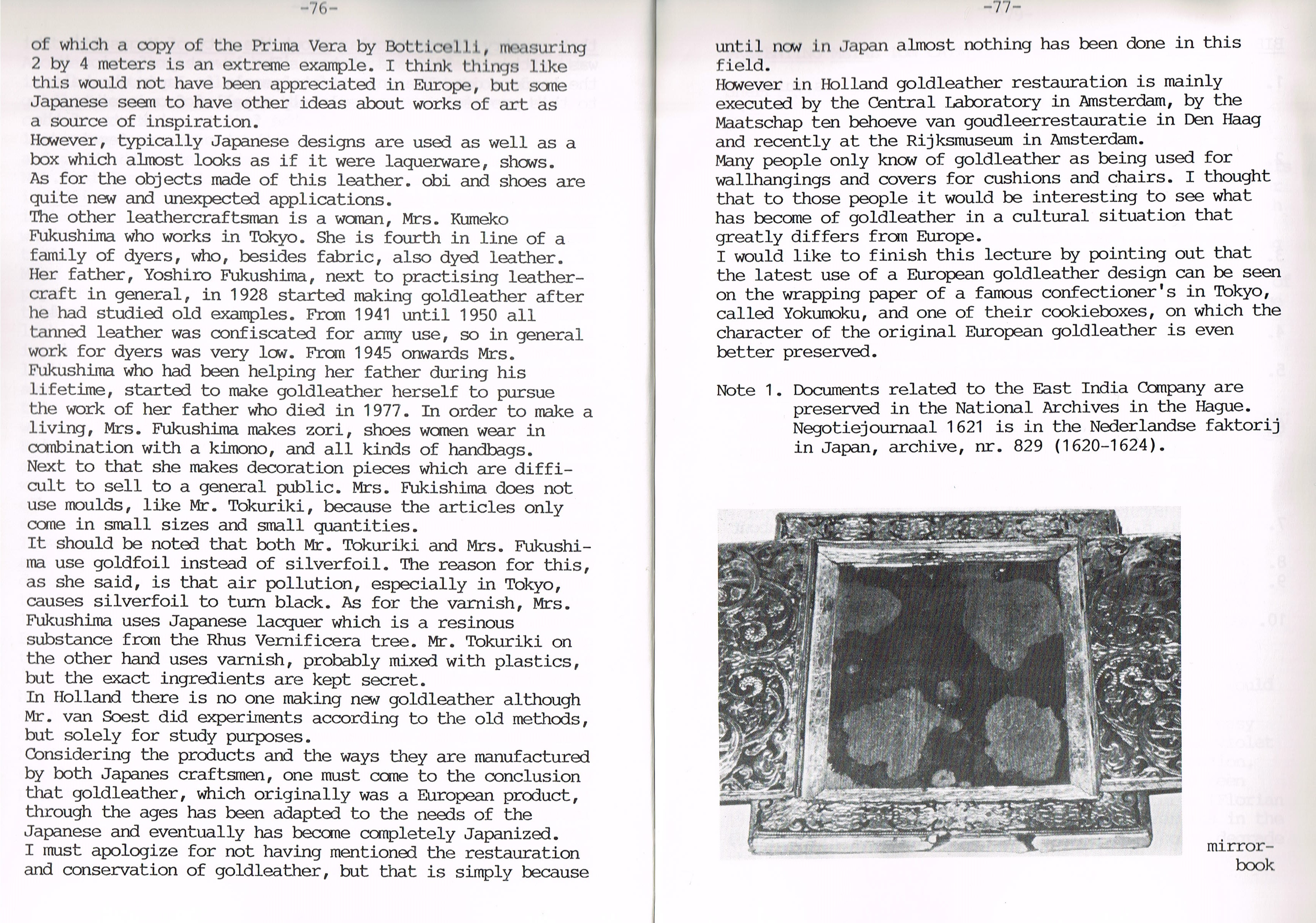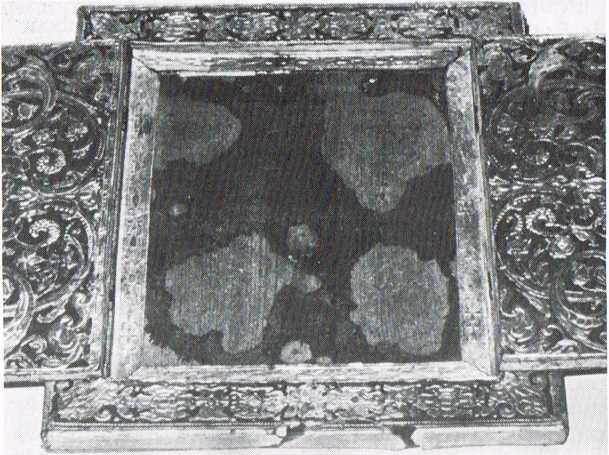CCI20140507�41

-76-
of which a oopy of the Prima Vera by Botticel1L, moasuring 2 by 4 meters is an extreme example. I think things like this would not have been appreciated in Europę, but some Japanese seem to have other ideas about works of art as a source of inspiration.
However, typically Japanese designs are used as well as a box which almost looks as if it were laąuerware, shcws.
As for the objects madę of this leather. obi and shoes are quite new and unexpected applications.
The other leathercraftsman is a woman, Mrs. Kumeko Fukushima who works in Tokyo. She is fourth in linę of a family of dyers, who, besides fabric, also dyed leather.
Her father, Yoshiro Fukushima, next to practising leather-craft in generał, in 1928 started making goldleather after he had studied old examples. From 1941 until 1950 all tanned leather was confiscated for army use, so in generał work for dyers was very Iow. From 1945 onwards Mrs. Fukushima who had been helping her father during his lifetime, started to make goldleather herself to pursue the work of her father who died in 1977. In order to make a living, Mrs. Fukushima makes zori, shoes women wear in combination with a kimono, and all kinds of handbags.
Next to that she makes decoration pieces which are diffi-cult to sell to a generał public. Mrs. Fukishima does not use moulds, like Mr. Tokuriki, because the articles only come in smali sizes and smali quantities.
It should be noted that both Mr. Tokuriki and Mrs. Fukushima use goldfoil instead of silverfoil. The reason for this, as she said, is that air pollution, especially in Tokyo, causes silverfoil to tum black. As for the vamish, Mrs. Fukushima uses Japanese lacąuer which is a resinous substance from the Rhus Vemificera tree. Mr. Tokuriki on the other hand uses vamish, probably mixed with plastics, but the exact ingredients are kept secret.
In Holland there is no one making new goldleather although Mr. van Soest did experiments according to the old methods, but solely for study purposes.
Considering the products and the ways they are manufactured by both Japanes craftsmen, one must come to the conclusion that goldleather, which originally was a European product, through the ages has been adapted to the needs of the Japanese and eventually has become completely Japanized.
I must apologize for not having mentioned the restauration and conservation of goldleather, but that is simply because until now in Japan almost nothing has been done in this field.
However in Holland goldleather restauration is mainly executed by the Central Laboratory in Amsterdam, by the Maatschap ten behoeve van goudleerrestauratie in Den Haag and recently at the Rijksmuseum in Amsterdam.
Many people only know of goldleather as being used for wallhangings and covers for cushions and chairs. I thought that to those people it would be interesting to see what has become of goldleather in a cultural situation that greatly differs from Europę.
I would like to finish this lecture by pointing out that the latest use of a European goldleather design can be seen on the wrapping paper of a famous confectioner's in Tokyo, called Yokumoku, and one of their cookieboxes, on which the character of the original European goldleather is even better preserved.
Notę 1. Documents related to the East India Company are preserved in the National Archives in the Hague. Negotiejoumaal 1 621 is in the Nederlandse faktorij in Japan, archive, nr. 829 (1620-1624).

mirror-
book
Wyszukiwarka
Podobne podstrony:
280 Z. KORUBA ET AL. six degrees of freedom in the discrete model of the system described by ana-lyt
HelpList1?se a i? Drive all the item pieces to the bottom of the gamę field by gettin
147 SUE AR Sorr.e elementary principles of shell stress analysis with notes on the use of the shear
37 - agricultural eztension service9 and improve the quality and relevance of the training provided
STRATEG IC PLANS TO ADDRESS CHALLENGESRcduce CostReview of the ICL contract by both ICL and theTCIG
skanuj0266 NORA 2 shutcles Make the upper and lowcr part of the wing one by one and join them&n
46096 mbs 075 MY BREATHING SYSTEM now becn convinced of the fact that this “ mania for exercise ” is
Materials The fabric that was used for the Viborg shirt is an extremeiy uniform tabby weave madę of
carving?ce The Exaggerated Expression 27 Figs 50 to 53 show the deep folding of the cheek *med by t
1933 League of Nations — Treaty Series. 401 would, by the laws of the country or by a testament
Article 8. Should a European Power attempt to nndennine the independenci oI one of the Contracting P
więcej podobnych podstron